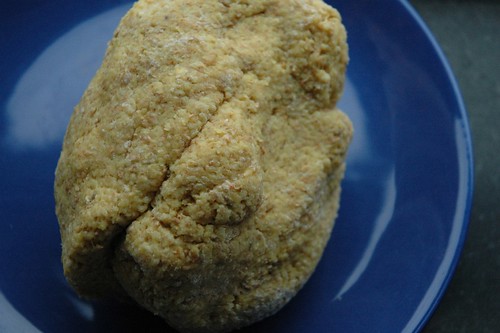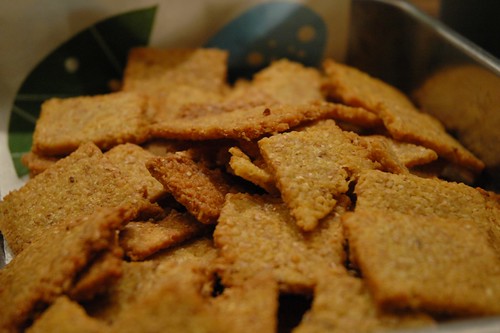Sakkarpara are fried spicy wheat crisps that are made out of wheat flour and cream of wheat, or semolina flour. These are like spicy chips or crackers. My mom used to make these, and now does so when we visit home, or she travels to see us. Being away from my parents, I have decided to try my hand at some of those traditional Guju foods my mom made. I imagine that her recipes had to change once she emigrated to the US, similar to how I have had to adapt many recipes because I cannot find the ingredients, or they are unavailable. I was unable to find cream of wheat or semolina flour, so I used a fine ground couscous.
Above: all-purpose flour, whole-wheat flour, and fine semolina
Above: Mom's recipe
Sakkarpara are usually served both savory and sweet. They are usually consumed for breakfast or during tea time. They travel and store well in airtight containers. I prepared my mom’s recipe in two batches, adjusting the couscous and the wheat flour. I have included her original recipe below, with my adjustments in parentheses besides each item. I found that they used a lot less oil and cooked quickly while being fried at 300 F. They store well, if you can manage not eating all of them in a few days.
Above: cumin seeds, turmeric, red chili powder
The sakkarpara are ready to fry as soon as the dough has been made and rolled out. If you are not going to fry these immediately, store the dough in a small bowl. To make the rolling easier, split the dough ball into two pieces. Have ample all-purpose flour ready to coat your work surface so the dough will not stick. I used almost 1/2 cup in rolling these out. The chips can be dusted with flour to prevent them from sticking (the extra flour will really tax the frying oil, but you can strain the oil through a tea sieve once its cooled off). The addition of cooked couscous allow these to puff up and gives you a soft wet dough.
Above: the sakkarpara dough ready to be rolled out. This one is a bit on the drier side, you want it moister than this.
Above: dough is rolled and cut up.
Above: ready to make some?
Gujarati Sakkarpara
Yield: 50-60 chips
1 cup wheat flour or mixture of all-purpose and whole-wheat flour
1 cup cream of wheat, or 1/2 cup of dried couscous prepared with 1 cup boiling water. This will yield about 1 and 1/2 cups cooked couscous.
½ tsp turmeric, use ¼ tsp if using fresh turmeric
½ tsp red chili powder
½ tsp whole cumin seeds
½ tsp salt
1 tbsp brown sugar
¼ tsp citric powder (I omitted, because I couldn’t find it)
1 tbsp vegetable oil
1/2 cup water, or more as needed
2 cups peanut oil
Directions:
- Combine the flour and cream of wheat (or cooked couscous if using) in a large mixing bowl. Next, add in turmeric, red chili powder, salt, cumin seeds, brown sugar and citric acid (if using) and stir well.
- Stir in vegetable oil and mix well.
- Add in the water in ¼ cup increments, mixing the dough together. You want to make a soft dough, and the cream of wheat will soak up the water (the cooked couscous will make the dough wetter, so you might need more flour). If the dough is too dry, add in water 1 tsp at a time until you get it to be the right consistency. Form a ball.
- Once ready to roll the dough, split the dough into two even balls.
- Sprinkle a clean work surface with the reserved flour, and push down the dough (dusted in flour) into a 3-4 inch disc. Roll out the dough, rotating the dough every few rolls, so you can get a circle. Flip it over frequently to make sure it is not sticking. Use more flour as needed. If you get another shape, just work with it, it doesn’t matter. Roll out until ⅛ inch thick.
- With a small paring knife, cut strips along the length of the dough, and then cut strips along the width, so you get squares or diamonds. You can flour these lightly, so they do not stick.
- Heat up the 2 cups of peanut oil in a wide oil-safe pot over medium-high heat. The oil is ready when it is between 275 and 300 F. You may need to turn the heat down to medium once it comes to temperature. If you don’t have a thermometer, the oil is ready when it bubbles rapidly after placing the sakkarpara chips in the hot oil.
- When ready, add in 5-7 chips at a time and cook for 3-4 minutes. Be careful not to crowd the pan because it will extend the cooking time. The sakkarpara are done once they are golden-brown. Remove the sakkarpara with a slotted spoon and set on a dish lined with paper towels.
Note: This recipe was tested again with cooked couscous instead of dried couscous and the changes made a much easier dough and sakkarpara. The changes have been reflected in the recipe above.























